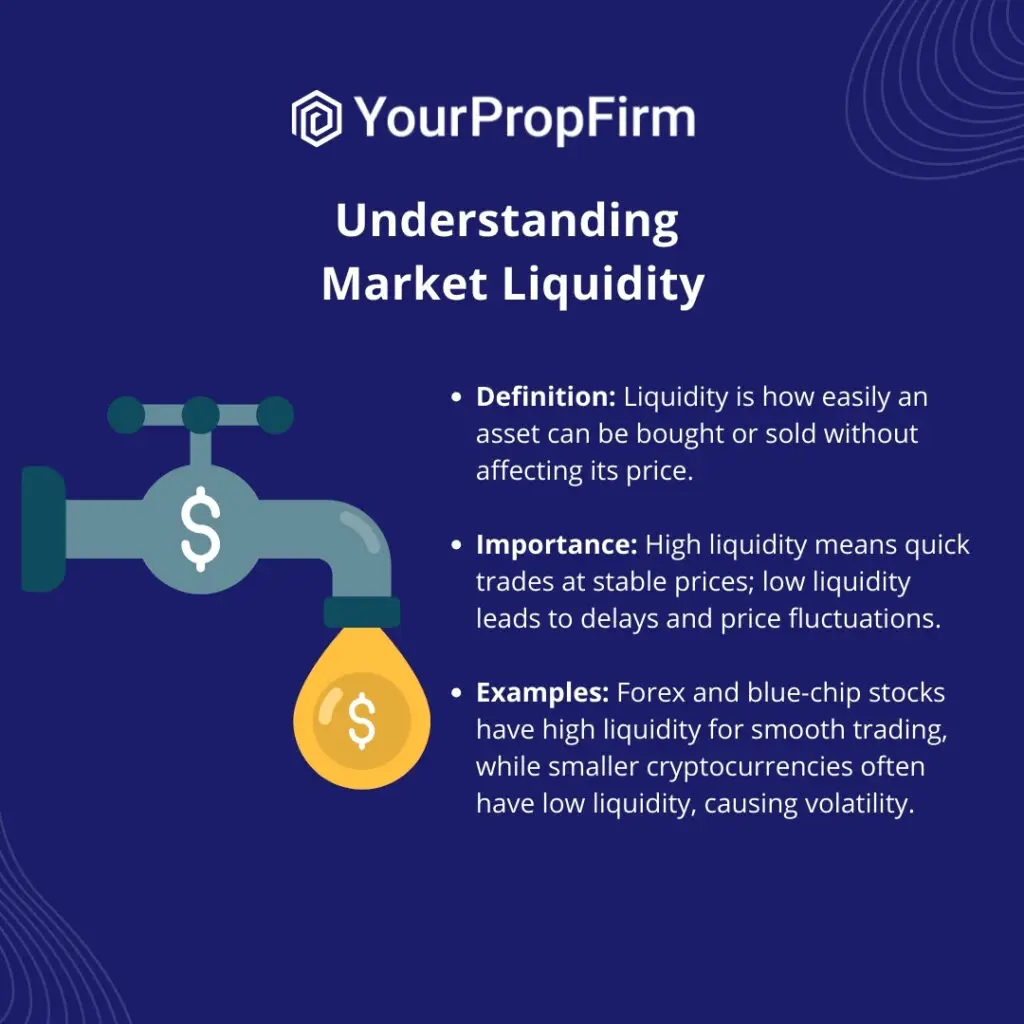Introduction to Market Dynamics
Liquidity providers and market makers are essential components of financial markets, each playing distinct roles in ensuring smooth and efficient trading. Liquidity providers are entities that supply the necessary funds to execute trades without causing significant price changes. They help maintain market liquidity by being ready to buy or sell assets at any time. On the other hand, market makers actively participate in the market by quoting both buy and sell prices for a specific asset, facilitating trading and contributing to market stability.
Understanding these roles sets the stage for an in-depth exploration of their functions. Liquidity providers and market makers significantly influence market liquidity, price stability, and the overall trading experience. By delving into their operations, we can better appreciate their impact on financial markets and traders.
Understanding Market Liquidity

Liquidity refers to how easily an asset can be bought or sold in a market without affecting its price. It is crucial in financial markets because it ensures that traders can enter and exit positions smoothly and that prices remain stable. High liquidity means there are many buyers and sellers, making it easier to execute trades quickly and at desired prices. Low liquidity can lead to delays and unfavorable prices. Liquidity helps maintain stable prices; in a highly liquid market, large trades have less impact on prices, while in an illiquid market, even small trades can cause significant price fluctuations.
Analogies to Illustrate Liquidity
To illustrate liquidity, consider the job market. In a highly liquid job market, many employers are hiring, and many individuals are seeking jobs, allowing job seekers to find employment quickly without drastic changes in salary offers. Similarly, in a liquid financial market, assets can be traded rapidly without large price shifts.
Impact on Different Markets
In the Forex market, liquidity is typically high, especially for major currency pairs like EUR/USD, allowing trades to be executed almost instantly at stable prices. In the stock market, blue-chip stocks usually have high liquidity due to the large number of shares traded daily, making it easy for investors to buy and sell without significantly affecting prices. In the crypto market, liquidity varies widely. Major cryptocurrencies like Bitcoin and Ethereum generally have high liquidity, allowing for quick trades and stable prices, while smaller, less-known cryptocurrencies can be highly illiquid, leading to greater price volatility and difficulty in executing trades.
Understanding liquidity helps traders navigate different markets more effectively, ensuring they can make informed decisions about where and how to trade.
Role of Liquidity Providers
Liquidity providers are entities that supply the necessary funds to execute trades in financial markets. They play a crucial role in the financial ecosystem by ensuring that there is always enough liquidity, which helps to maintain market stability and efficiency. In Forex markets, liquidity providers facilitate smooth and continuous trading by being ready to buy or sell currency pairs at any time.
Types of Liquidity Providers
Various types of liquidity providers operate in the financial markets:
- Commercial Banks: These are major players in the Forex market, providing significant liquidity due to their large-scale currency transactions.
- Central Banks: They influence liquidity by implementing monetary policies, which can affect currency supply and demand.
- Retail Speculators: Individual traders or smaller institutions that provide liquidity through their trading activities.
Services Provided
Liquidity providers offer several services that impact the trading process:
- Straight Through Processing (STP): This service allows traders’ orders to be sent directly to liquidity providers without any dealing desk intervention. It ensures faster and more transparent trade execution.
- Direct Market Access (DMA): DMA gives traders the ability to interact directly with the order books of liquidity providers. This access allows for greater control over trading strategies and often results in better pricing and execution.
- Electronic Communication Network (ECN): ECN is a type of computerized network that facilitates trading by matching buy and sell orders within the network. It provides a high level of transparency and often features tighter spreads due to the competition among liquidity providers.
These services help streamline the trading process, reduce costs, and enhance the overall trading experience for market participants.
Role of Market Makers
Market makers are entities or individuals that actively create and maintain markets for specific financial instruments, such as stocks and commodities. Their role involves providing liquidity by quoting both buy and sell prices for these instruments, ensuring that trades can be executed quickly and efficiently.
Functions of Market Makers
Market makers perform several critical functions:
- Maintaining Two-Sided Quotes: Market makers continuously provide buy (bid) and sell (ask) prices for the financial instruments they cover. This helps create a liquid market where traders can always find a counterparty for their trades.
- Stabilizing Spreads: By consistently quoting buy and sell prices, market makers help to stabilize the bid-ask spread, which is the difference between the highest price a buyer is willing to pay and the lowest price a seller is willing to accept. This stability reduces transaction costs for traders.
- Ensuring Trading Volumes: Market makers ensure there is sufficient trading volume by being ready to buy or sell at their quoted prices. This commitment helps maintain an active and orderly market, preventing excessive volatility.
Regulatory Framework
The operation of market makers is governed by a legislative and regulatory environment designed to ensure fair and transparent market practices. Regulatory bodies such as the Securities and Exchange Commission (SEC) in the United States set rules and guidelines that market makers must follow. These regulations include requirements for maintaining adequate capital, adhering to fair trading practices, and reporting trading activities. The goal is to protect investors and maintain the integrity of financial markets.
Differences Between Liquidity Providers and Market Makers
Methods of Operation:
- Liquidity Providers: Supply the necessary funds to execute trades, acting as intermediaries between buyers and sellers. They do not typically hold an inventory of assets but facilitate transactions to ensure market liquidity.
- Market Makers: Actively create and maintain markets by quoting buy and sell prices for specific financial instruments. They hold inventories of assets and are ready to buy or sell at any time to ensure market activity.
Motivations:
- Liquidity Providers: Aim to earn fees and commissions from facilitating trades. Their primary motivation is to provide sufficient liquidity to the market to enable smooth trading.
- Market Makers: Earn profits from the spread between buy and sell prices. Their motivation includes maintaining tight spreads and managing their inventory to optimize profitability.
Impacts on the Market:
- Liquidity Providers: Enhance market depth and ensure that trades can be executed without significant price changes. They contribute to market efficiency by supplying continuous liquidity.
- Market Makers: Stabilize prices and reduce volatility by providing constant buy and sell quotes. They play a crucial role in price discovery and maintaining orderly markets.
Impact on Traders and the Market
1. Improved Liquidity
Liquidity providers ensure that there are always enough funds to execute trades, making it easier for traders to buy and sell assets without significant delays.
2. Reduced Transaction Costs
Market makers maintain tight bid-ask spreads, which lowers the cost of trading by reducing the difference between buy and sell prices.
3. Enhanced Market Accessibility
Both liquidity providers and market makers ensure that traders can enter and exit positions easily, contributing to a more accessible and inclusive market environment.
4. Price Stabilization
Market makers help stabilize prices by continuously quoting buy and sell prices, preventing large price swings and reducing volatility.
5. Increased Market Efficiency
Both entities contribute to market efficiency by ensuring that trades can be executed swiftly and at fair prices, facilitating smoother market operations and better price discovery.
These benefits and their roles in maintaining stable and efficient markets make liquidity providers and market makers indispensable to the financial ecosystem.
Evolution and Future Trends
The roles of liquidity providers and market makers have evolved significantly over time. Initially, market makers dominated by providing continuous buy and sell quotes and holding large inventories of assets. As financial markets became more complex, liquidity providers emerged to ensure there was always enough capital to facilitate trades, improving market depth and efficiency. Today, both entities play crucial roles in maintaining market stability and liquidity.
Future Trends in 2024
Technological advancements and regulatory changes are likely to further shape the roles of liquidity providers and market makers in 2024.
1. Technological Advancements
Automation and artificial intelligence will continue to revolutionize trading. Advanced algorithms and machine learning will enable liquidity providers and market makers to execute trades more efficiently, predict market movements, and manage risks better. Blockchain technology may also play a role, enhancing transparency and reducing transaction times.
2. Regulatory Changes
Increasing regulatory scrutiny will push for greater transparency and fair practices. Regulators may implement stricter rules to ensure that both liquidity providers and market makers operate in ways that protect traders and enhance market integrity. Compliance with these regulations will be crucial, influencing how these entities conduct their operations.
3. Integration of Decentralized Finance (DeFi)
The rise of decentralized finance (DeFi) could impact traditional liquidity providers and market makers. DeFi platforms offer peer-to-peer trading without intermediaries, which may change how liquidity is provided and how market making is conducted. Traditional entities might integrate DeFi technologies to stay competitive.
These trends indicate that liquidity providers and market makers will continue to adapt and evolve, driven by technological innovations and regulatory developments, ensuring they remain vital to the financial markets.
Frequently Asked Questions (FAQ)
What are the main differences between a liquidity provider and a market maker?
Liquidity providers supply the necessary funds to facilitate trades, ensuring there is enough liquidity in the market. They act as intermediaries between buyers and sellers but do not typically hold an inventory of assets. Market makers, on the other hand, actively create and maintain markets by quoting buy and sell prices for specific assets. They hold inventories and are always ready to trade, providing constant liquidity and stabilizing prices.
How do liquidity providers and market makers make money?
Liquidity providers earn money through fees and commissions by facilitating trades. They may charge a small fee for each transaction they help execute. Market makers profit from the spread between the buy (bid) and sell (ask) prices. By maintaining tight spreads and managing their inventories effectively, market makers can generate significant revenue from the difference in these prices.
What are the implications of these roles for a regular trader?
For regular traders, the presence of liquidity providers and market makers ensures that they can buy and sell assets easily and at fair prices. Liquidity providers contribute to market depth, making it easier to execute trades without causing significant price changes. Market makers help stabilize prices and reduce volatility, creating a more predictable trading environment. Both roles enhance overall market efficiency, making trading smoother and more accessible for all participants.
Conclusion and Closing Thoughts
Understanding the roles of liquidity providers and market makers is crucial when choosing trading platforms or brokers. Liquidity providers ensure smooth trade execution and market depth, while market makers offer price stability and reduced volatility. Recognizing how these entities operate helps traders make informed decisions, improving their trading experience and success.
For those interested in exploring more about market dynamics, consider reading “The Market Maker’s Edge” by Josh Lukeman or “Market Liquidity: Theory, Evidence, and Policy” by Thierry Foucault, Marco Pagano, and Ailsa Roell. Online courses from platforms like Coursera and Investopedia also offer valuable insights into market structures and trading strategies.
Further Resources
Books:
- “The Market Maker’s Edge” by Josh Lukeman: This book provides practical insights into the strategies used by market makers.
- “Market Liquidity: Theory, Evidence, and Policy” by Thierry Foucault, Marco Pagano, and Ailsa Roell: A comprehensive guide on market liquidity and its implications.
- “Trading and Exchanges: Market Microstructure for Practitioners” by Larry Harris: An in-depth look at the mechanics of financial markets.




